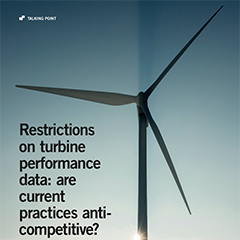As recent zero-subsidy projects show, the cost of wind energy is decreasing at an impressive rate. Nonetheless, production and maintenance costs remain high compared with rival sectors. One key route to decreasing overheads is the effective use of performance data. In many similar industries, data is used to streamline maintenance systems and reduce O&M costs through real-time management and predictive systems.
However, in the wind industry turbine performance data is often unavailable, meaning owners and operators are not free to make use of data-based efficiency increases.
By far the largest contributor to OPEX costs in the wind industry is O&M-related expenditure, the majority of which is caused by unplanned maintenance (see Figure 1). Reducing the expenses that result from unplanned maintenance will be key to further reducing the overall levelized cost of energy (LCoE). Within the industry, there is growing acceptance that the best way to reduce unplanned maintenance is to switch from a reactive approach to a more predictive regime, using data-based approaches to better anticipate and respond to maintenance issues.
Many, if not all, owners and operators are already investing in predictive maintenance solutions, such as improved SCADA data analytics, condition monitoring systems (CMS), and oil monitoring. Such techniques require large datasets to function effectively. Machine learning-based systems, for example, become more accurate as more data is received. In general, effective predicative maintenance is contingent on an uninterrupted stream of readable, high-quality data.
Despite this, the data necessary for such systems is not always readily available. Often, data that was assumed to be accessible turns out not to be, and data that was known to be accessible is, on closer inspection, encrypted. There is no clear approach to data access across suppliers: some providers allow owner and operators substantial access to data, while others restrict access to a subset of highly-processed data or even restrict access completely. Using access to CMS data as one example from among the many data feeds produced by a wind turbine, Table 1 in Figure 2 illustrates the extent to which hardware providers limit access to CMS data.



























